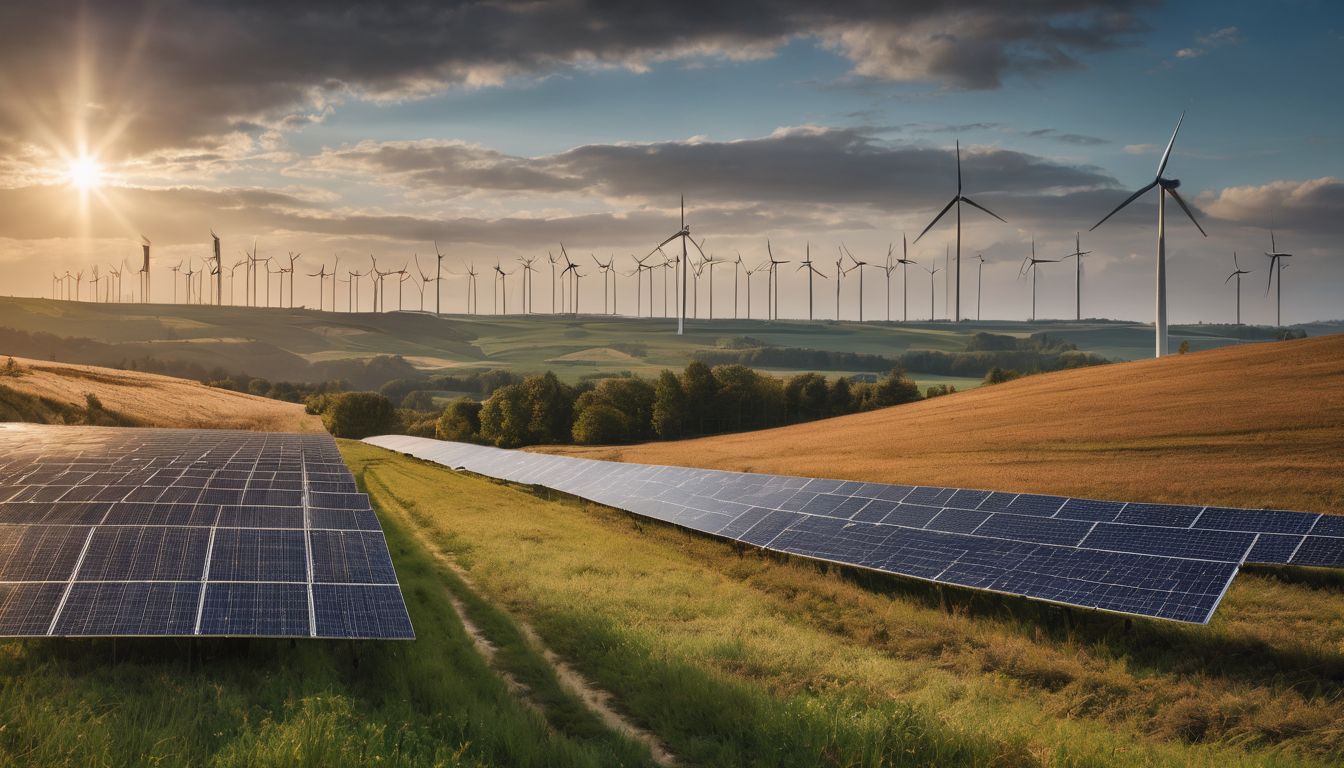With energy costs rising and the planet’s health in our hands, many of us are searching for greener ways to power our lives. Biomass energy, a renewable source derived from organic materials like plants and waste, offers a compelling solution to this modern dilemma.
This blog post will explore how tapping into biomass can fuel a more sustainable future, reducing carbon footprints without compromising on energy needs. Dive in to discover biomass energy’s vital role in eco-friendly living!
Key Takeaways
- Biomass energy comes from organic materials, like wood and agricultural waste; it’s a renewable energy source that helps reduce our carbon footprint and dependence on fossil fuels.
- Advancements in biofuel technology are making biomass energy more efficient, with the potential to revolutionise transport and reduce greenhouse gas emissions significantly.
- Using biomass supports the agriculture and forestry sectors by creating new markets for crop residues and wood waste, boosting local economies, especially in rural areas.
- Technological innovations are improving the cost – effectiveness of producing biomass energy, enhancing its economic viability as a sustainable alternative to traditional fuels.
- The integration of biomass into daily living practices encourages sustainable living while promoting industry growth and reducing environmental impact through lower emissions.
Understanding Biomass Energy
Biomass energy is derived from organic plant and animal materials, such as wood, crop residues, and animal manure. It can be converted into useful forms of energy like heat, electricity, or biofuels.
Examples of biomass energy sources include wood and wood processing wastes, agricultural crops and waste materials, food, yard and wood waste collection in municipal solid waste (MSW), animal wastes, aquaculture wastes.
Definition and explanation
Biomass energy is the power we get from organic material, like plants and waste. This renewable energy source comes from materials that were once living or are still part of the ecosystem.
They can be quickly replenished and turned into fuel for our needs. Wood chips, agricultural residues, and even household garbage count as biomass resources.
People use this carbon-neutral form of energy to produce electricity, heat homes, and fuel vehicles. Biomass power plants convert these natural materials into usable energy while striving for environmental sustainability.
Unlike fossil fuels which take millions of years to form, biomass can be continuously grown and used without depleting resources permanently – making it a cornerstone of sustainable development strategies.
Examples of biomass energy sources
- Wood: This traditional source of biomass energy is derived from trees and forest residues. It can be processed into wood pellets or used directly for heating.
- Agricultural Residues: Byproducts of agricultural processes, such as crop residues and animal waste, are utilised to generate renewable energy.
- Energy Crops: Specially grown crops like switchgrass and willow trees are cultivated for their potential in bioenergy production.
- Algae: Algae offer a promising source of biofuel due to its rapid growth rate and high oil content.
- Organic Waste: Non-food biomass sources like sewage sludge, food waste, and municipal solid waste can be converted into biogas through anaerobic digestion.
- Landfill Gas: Methane produced from organic materials in landfills is collected and utilised as a renewable energy source.
- Aquatic Plants: Water plants like water hyacinth can be harvested and used for the generation of biomass power.
The Benefits of Biomass Energy
Biomass energy offers reduced greenhouse gas emissions, decreased reliance on foreign oil, and support for the agricultural and forestry industries. This makes it a sustainable and environmentally friendly alternative to traditional fuel sources.
Reduced greenhouse gas emissions
Biomass energy plays a crucial role in reducing greenhouse gas emissions. By using organic materials for fuel, such as wood pellets, agricultural residues, and biofuels derived from crops, the reliance on fossil fuels is lessened significantly.
This shift to sustainable energy sources helps decrease carbon emissions into the atmosphere, contributing to a cleaner and greener environment while mitigating the impact of climate change.
Furthermore, embracing biomass energy promotes a more sustainable way of living by supporting carbon-neutral initiatives and clean energy solutions. The reduction in greenhouse gas emissions through biomass utilisation not only benefits our environment but also sets the stage for economic development within the biomass industry.
Decreased reliance on foreign oil
Transitioning from reducing greenhouse gas emissions, biomass energy further offers the advantage of decreased reliance on foreign oil. By utilising plant matter and organic waste to produce biofuels, we reduce our dependence on non-renewable fossil fuels, thus enhancing energy security in a sustainable manner.
This shift towards using locally sourced biomass not only reduces the need for importing oil but also supports local agricultural and forestry industries, contributing to a more sustainable and self-sufficient energy future.
The diversification of energy sources through biomass plays a pivotal role in achieving carbon neutrality while fostering economic growth at home. With such benefits, embracing biomass energy presents an opportunity for individuals and nations alike to take meaningful steps towards reducing their environmental impact while promoting sustainable living practices.
Support for the agricultural and forestry industries
Biomass energy offers crucial support to the agricultural and forestry industries, providing new market opportunities for farmers and foresters. By utilising crop residues, wood chips, and other organic byproducts, these industries can generate additional revenue streams while contributing to sustainable energy production.
This not only helps in reducing waste but also fosters economic growth within rural communities that depend on agriculture and forestry as their primary sources of income.
Furthermore, biomass energy encourages sustainable land management practices by incentivising the responsible cultivation of fuel crops. This approach ensures that farmland remains productive while retaining biodiversity and supporting wildlife habitats.
The Potential of Biofuels
Biofuels, derived from organic matter, have shown promise in reducing greenhouse gas emissions and decreasing reliance on foreign oil. The role of photosynthesis in producing biofuels has opened up new possibilities for sustainable energy sources.
Advancements and promises
Advancements in biofuel technology have shown great promise in making biomass energy more efficient and accessible. Scientists are developing new methods to convert organic materials into renewable fuels, such as biodiesel and ethanol, which can be used for transportation and power generation.
The potential of using algae and organic waste as biofuel sources is an exciting frontier that holds the promise of reducing carbon emissions while supporting sustainable living. These advancements offer hope for a greener future by providing alternative energy options that reduce our dependence on fossil fuels.
The promises of biomass energy lie in its ability to create a carbon-neutral cycle by harnessing natural processes like photosynthesis. This renewable energy source has the potential to revolutionise how we meet our energy needs while contributing to environmental conservation efforts.
The role of photosynthesis
Photosynthesis plays a crucial role in the production of biomass energy. During photosynthesis, plants convert sunlight, water, and carbon dioxide into oxygen and organic compounds.
These organic compounds serve as the primary source for bioenergy production, such as biofuels and biopower. Biomass obtained from photosynthetic processes is renewable and helps to reduce reliance on fossil fuels, making it an essential component of sustainable living initiatives.
By harnessing the power of photosynthesis through biomass energy, we can significantly reduce greenhouse gas emissions and promote a cleaner environment for future generations. The integration of biomass energy derived from photosynthesis presents a viable solution for transitioning towards a more sustainable and carbon-neutral energy future.
Biomass Energy Integration for Building Sustainability
The integration of biomass energy into sustainable living practices is becoming increasingly popular due to advancements in technology and its economic viability. It offers a promising way to reduce environmental impact and promote green living.
Increasing popularity and advancements in technology
Advancements in technology have led to the increasing popularity of biomass energy as a sustainable alternative. Innovations in bioenergy production processes, such as gasification and pyrolysis, have made it more efficient and cost-effective.
Additionally, advancements in waste-to-energy technologies are enabling the conversion of organic waste materials into usable energy sources, further expanding the scope of biomass energy integration.
The growing interest in carbon-neutral energy solutions has driven investment and research into improving biomass energy technologies. As society continues to shift towards renewable alternatives, technological advancements will play a crucial role in enhancing the viability and scalability of biomass energy for sustainable living.
Economic viability
Biomass energy presents economic viability as a sustainable alternative to traditional fuels. The production of biofuels supports local economies and reduces reliance on imported oil, creating opportunities for job growth in agriculture and forestry.
Additionally, the use of biomass energy can contribute to carbon-neutral initiatives, providing financial incentives through reduced emissions and the potential for carbon credits.
Furthermore, advancements in technology continue to drive down the cost of producing biomass energy, making it an increasingly competitive option in today’s market. As industry growth continues, the economic benefits of integrating biomass energy into sustainable living practices become more apparent, offering both environmental and financial rewards for individuals and communities alike.
The Way Forward
Advancements in technology and industry growth are paving the way for greater integration of biomass energy into sustainable living practices. With the potential for reducing environmental impact, there is a call to action for promoting sustainable living through the use of biomass energy.
Potential for reducing environmental impact
Biomass energy holds great potential in reducing environmental impact. By using organic materials like crop residues and wood waste to produce energy, it helps lower greenhouse gas emissions and mitigates the negative effects of climate change.
Additionally, reliance on foreign oil decreases as biofuels offer a more sustainable alternative for transportation fuel. This integration of biomass energy into daily living supports the agricultural and forestry industries, promoting a circular economy that minimises waste and maximises resource efficiency.
As advancements continue in technology and industry growth, adopting biomass energy becomes increasingly feasible. The economic viability of this renewable energy source further solidifies its role in building sustainability.
Advancements in technology and industry growth
Advancements in technology and industry growth have led to increased efficiency in biomass energy production. Innovations such as advanced gasification techniques and the development of high-efficiency combustion systems are transforming how biomass is utilised for energy generation.
These improvements enhance the economic viability of biomass energy, making it a more attractive option for sustainable living. Furthermore, the integration of digital monitoring and control systems has optimised operations, ensuring minimal environmental impact while maximising output.
The growing momentum behind renewable energy sources creates an optimistic outlook for further advancements in technology and industry growth within the biomass sector. This progression is crucial in achieving widespread adoption of carbon-neutral energy solutions and driving towards a more sustainable future.
Call to action for promoting sustainable living.
Embrace carbon-neutral energy by integrating biomass examples into your daily routine. Support conservation efforts and the environment by reducing reliance on non-renewable resources.
Take the lead in promoting sustainable living and be an advocate for environmentally friendly practices within your community.
Make a conscious effort to reduce greenhouse gas emissions with biomass energy, contributing to a healthier planet for future generations. Show support for the agricultural and forestry industries by championing sustainability through carbon-neutral energy practices, paving the way for a greener world.
Conclusion
In conclusion, biomass energy plays a vital role in promoting sustainable living by reducing greenhouse gas emissions and supporting local industries. Its potential as biofuels offers promising advancements and decreased reliance on foreign oil.
Integrating biomass energy into our infrastructure will contribute to building a more sustainable future for generations to come. As environmentally conscious individuals, we can actively support the expansion of biomass energy to achieve a carbon-neutral environment.
FAQs
1. What is biomass energy and how does it support sustainable living?
Biomass energy is a renewable source made from organic materials like plants and waste, helping us live sustainably by providing carbon-neutral energy to power our homes and businesses.
2. Can biomass reduce our carbon footprint?
Absolutely! By using biomass for energy, we significantly lower our reliance on fossil fuels, which reduces greenhouse gas emissions, aiding in the creation of a more carbon-neutral environment.
3. Is biomass energy reliable compared to other renewables?
Yes, biomass is quite reliable because unlike solar or wind power that depend on weather conditions, it can produce constant energy since its resources are readily available year-round.
4. Why should we consider switching to biomass for our energy needs?
Switching to biomass helps cut down pollution caused by burning fossil fuels and plays a crucial role in moving towards a cleaner, more sustainable future with its carbon-neutral benefits.





